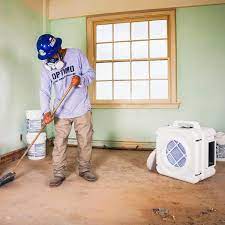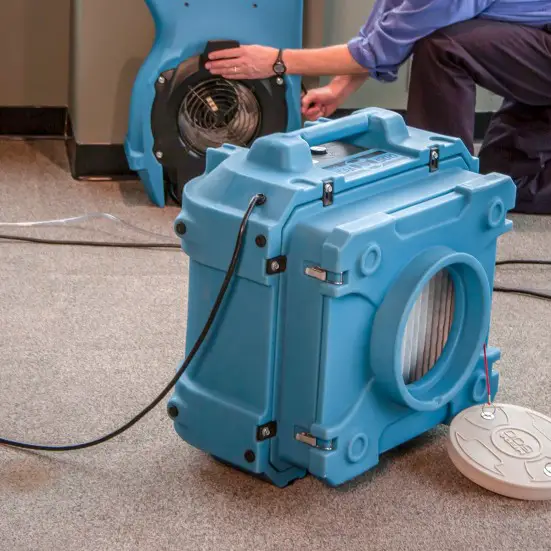Last Updated on May 7, 2024 by Peter Simmons
So what are air scrubbers, and what precisely do they do? In this post, you’ll learn what they are, what they do, how they work, whether they’re worth it, and the available types. You’ll also learn what they remove and how they compare to air purifiers. Let’s roll!
What is an Air Scrubber?
Contents
An air scrubber is an air purification system that cleans the air more thoroughly than traditional air filtration methods.
This sophisticated system typically integrates into the air ducts of central air conditioning systems. Both systems become a comprehensive filtration system that includes a primary HEPA filter, an optional carbon filter, plus fans and motors.
Traditional HVAC systems often struggle to keep up with the volume of airborne particles in today’s polluted air. Air scrubbers step up to the plate and address these shortcomings.
They’re useful in environments with significant air pollution concerns. Residential scrubbers clean indoor air in homes, while complex systems used in industries adsorb gases and capture particulates.
Image via Saferack.com
Industrial or commercial applications include waste incineration, wastewater treatment plants, biogas plants, fish processing, power generation, cement production, steelmaking, commercial kitchens, and hospitals.
How an Air Scrubber Works
When the air gets in from outside, it passes through a pre-filter that captures larger particles like dust, pet dander, and pollen. Then, the air moves into the primary filtration system. This system usually features a HEPA filter. This highly effective filter traps microscopic contaminants that the pre-filter couldn’t remove.
Optionally, the air can go through a carbon filter, which removes odors and gaseous pollutants, including volatile organic compounds. A fan and motor system circulate the air, ensuring efficient filtration.
Once the air has been thoroughly cleaned, it’s released back into the indoor environment, creating a healthier atmosphere. Air scrubbers can run for hours, keeping your indoor environment sanitized and safe.

Remodeling your home does get easier with the right construction dust equipment
Types of Air Scrubbers
There are at least 5 main types of air scrubbers, namely:
- Wet scrubbers
- Dry scrubbers
- Electrostatic precipitators (ESPs)
- Integrated air scrubbers
- Portable air scrubbers
1. Wet Air Scrubbers
A wet scrubber controls air pollution by using liquid to clean contaminants from a gas stream. The gas and liquid meet, and the contaminants move into the liquid. The water used in this process is changed regularly.
Manufacturing, semiconductor, and chemical industries use these air purification systems to clean up harmful fumes and gases.
2. Dry Air Scrubbers
A dry scrubber cleans harmful chemicals from industrial exhaust gases. It sprays dry chemicals into the exhaust stream to neutralize or change pollutants. These chemicals react differently based on the targeted material.
Some neutralize pollutants through chemical reactions, while others cause them to change into harmless substances. The treated substances either fall out of the gas stream or are caught in a filter.
Dry scrubbers mainly remove acid gases from combustion sources. They do this by adding dry reactants to exhaust gas quickly. This cancels out the pollutants in the gas. This happens in three steps: cooling the gas, adding the reactants, and filtering it.
Learn more about dry scrubbers here.
3. Electrostatic Precipitators
Electrostatic Precipitators (ESPs) use electrical charge to remove particles from the air. Here’s how they work:
First, air containing particulate matter passes through an ionization section, where the particles get an electrical charge. Then, the charged particles are attracted to oppositely charged plates called collectors, where they stick. Finally, the clean air passes through, and the collected particles are removed from the plates.
4. Integrated Air Scrubbers
Integrated air scrubbers are built-in systems designed to clean the air within a building or HVAC system. They work by pulling air through filters that capture dust, allergens, pollutants, and other harmful particles.
These air scrubbers are typically integrated into the existing HVAC (Heating, Ventilation, and Air Conditioning) system. This integration allows them to clean the air as it circulates through the building. Installing this air scrubbing system helps to maintain good indoor air quality and reduce the risk of airborne contaminants.
5. Portable Air Scrubbers
Portable air scrubbers are movable air cleaning systems used to clean the air in a room. They’re not as big and cumbersome as their industrial application counterparts. This means you can easily carry or transport them from one place to another.
Portable air scrubbers pull in air and pass it through filters to remove dust, allergens, pollutants, and other harmful particles.
Where are they used? They’re commonly used in construction sites, renovation projects, disaster restoration, and indoor environments.
How Does an Air Scrubber Work?

The process starts when an air scrubber pulls in air from the surrounding environment or within a building. Before entering the main filtration system, the air passes through a pre-filter. Pre-filtration captures larger particles like dust, hair, and debris.
The main filtration system includes a primary HEPA filter for smaller particles, an activated carbon filter for odors and gases, and sometimes additional filters for specific contaminants.
Contaminants are trapped within the filter media, and clean air is released, improving indoor air quality. Regular maintenance, including filter replacement and cleaning, is essential for effectiveness.
Why Use an Air Scrubber?
Air scrubbers aren’t cheap for the most part. So, why should anyone invest in them? It’s because:
1. They Reduce Indoor Contaminants
Air scrubbers remove air contaminants like dust, pollen, mold spores, pet dander, bacteria, odors, gases, and volatile organic compounds (VOCs). They also take out chemical pollutants.
But do air scrubbers remove gaseous pollutants? Yes, if they’re equipped with charcoal or activated carbon filters.
Activated carbon has a high surface area and adsorptive properties. Adsorption isn’t the same thing as absorption, by the way. Learn the difference between adsorption and absorption here. These characteristics enable this material to capture and remove odors, volatile organic compounds (VOCs), and other airborne chemical compounds.
2. They Tackle Lingering Odors
Air scrubbers use activated carbon filters to eliminate bad smells. Activated charcoal is highly porous and boasts a large surface area, which enables it to adsorb odorous molecules from the air.
When air passes through the activated carbon filter, the odorous molecules become trapped within the carbon pores. That’s how these machines neutralize odors from the air.
3. They Help Reduce Irritating Particles
Air scrubbers help reduce irritating particles at home by filtering out various contaminants from the air. They typically include pre-filters to capture larger particles like dust, hair, and debris.
Their main filtration system features a HEPA filter to trap smaller particles such as pollen, mold spores, and pet dander.
Removing allergens and respiratory irritants from the air leads to a healthier indoor environment. Your home’s air gets sanitized, improving the quality of your life, even if you battle allergies.
*Please talk to your doctor if you suffer from allergies. These aren’t medical devices.
4. Installing them Can Extend Your HVAC’s Lifespan
How does adding an air scrubber system to your HVAC system improve longevity? By removing contaminants such as dust, pollen, mold spores, and bacteria from the air.
When they take out these contaminants, air scrubbers help prevent these particles from accumulating within the HVAC system’s components.
Reducing particle buildup reduces strain on the system, improves airflow, and decreases wear and tear. And components like the fan, motor, and coils last much longer.
Also, coupling your heating and cooling system with a residential air scrubber cuts the frequency of maintenance and repairs. You could save a buck or two, and your HVAC system will last longer.
Air Scrubber FAQs
Air Scrubber vs Air Purifier
Air purifiers focus on removing particles as small as 0.3 microns, while air scrubbers tackle larger particles and clean surfaces in industrial settings. Purifiers can’t remove particles on surfaces, only airborne ones, while air scrubbers remove suspended and on-surface contaminants. They’re scrubbers, after all.
Standalone air scrubbers mostly don’t use filters like air purifiers. They produce negative ions with ultraviolet light to neutralize viruses, bacteria, and pollutants as the air passes.
Also, air scrubbers are pricier but are better at removing larger particles like sawdust, metal, or silica dust, while air purifiers are more effective with smaller particles like viruses or bacteria. Besides that, air scrubbers are noisier and require maintenance and filter replacement more frequently.
Is an Air Scrubber Worth It?
Yes, a good air scrubber is worth it. It improves indoor air quality by removing contaminants, including pollutants, allergens, and pathogens. It’s particularly beneficial for individuals who suffer from allergies or respiratory issues.
It’s also a smart buy for those in areas with poor outdoor air quality. What’s more, air scrubbers can help reduce the spread of viruses and germs. They do that by eliminating airborne pathogens.
Do I Need an Air Scrubber?
Whether or not you need an air scrubber depends on your goals and the current air quality. Investing in indoor air quality testing tools can help you decide whether to upgrade your home air filtration.
According to the American College of Asthma& Immunology, HEPA air filters can take out up to 99.97% of indoor pollutants (irritants) 0.3 microns in diameter. You know what’s even better? HEPA-standard air filters remove particles smaller than 0.3 microns, even better! Get a HEPA air scrubber or air purifier if you desire clean indoor air.
However, installing an air scrubber won’t eliminate the need for medications or allergy shots, according to Healthline.
Does an Air Scrubber Attach to Your HVAC?
Yes, some air scrubbers can be integrated into your HVAC system. These are installed in ductwork, turning your HVAC system into a whole-house air purification system. However, not all air scrubbers integrate into the heating and cooling system. Some are standalone, portable units.
Will an Air Scrubber Help Allergies and Asthma?
Studies show that utilizing air scrubbers and portable air cleaners might improve asthma symptoms. They reduce environmental allergy and asthma triggers, aka allergens. However, evidence of allergy and asthma symptom improvement is inconclusive, according to Healthline.
Why Add Extra Filtration to My HVAC System?
Because adding an air scrubber to your HVAC system improves indoor air quality. The system captures a wide range of contaminants and irritants: dust, pollen, pet dander, mold spores, bacteria, and viruses. Also, integration can help extend the system’s lifespan.
